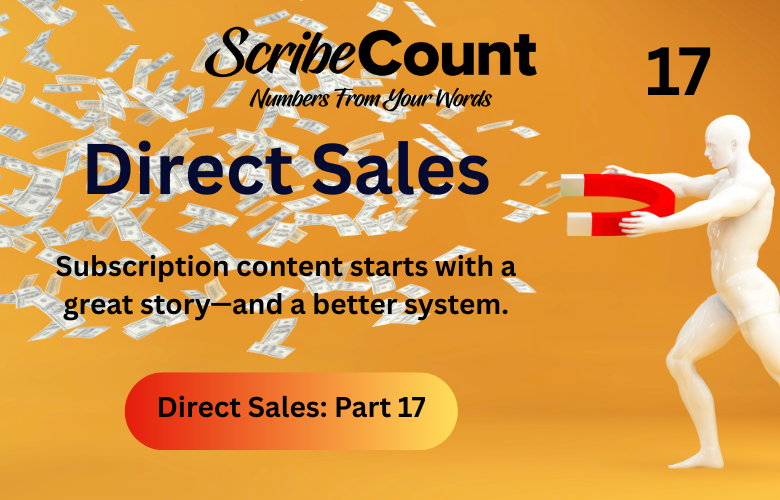Subscription-Based Content Through an Author Website
Selling books directly through your author website is more than a way to increase royalty percentages—it's a chance to build lasting reader relationships and predictable monthly income. For indie authors looking to expand beyond one-time sales, subscription-based content offers a scalable and sustainable model. This approach allows readers to support you on a recurring basis in exchange for ongoing value, whether digital, physical, or experiential.
This article explores what subscription content looks like through a direct storefront, why it matters for reader loyalty and business growth, how the underlying tools work, and what it takes to create a compelling subscription offer that readers will want to stick with.
Defining Subscription-Based Content for Indie Authors
Subscription-based content is a publishing model in which readers pay at regular intervals—monthly, quarterly, or annually—to receive ongoing value from the author. That value might take the form of serialized chapters delivered by email, early access to books before public release, access to private videos or writing commentary, exclusive novellas, book boxes, or physical merch bundles.
It is not just a payment model; it's a reader experience. Instead of buying one book and walking away, subscribers are invited into your creative world. They're not just customers—they're stakeholders in your author career.
The Benefits of Running Subscription Content on Your Own Website
Running subscription services through your own Shopify or WooCommerce store offers major advantages. First, you own the data. You control pricing, branding, delivery schedules, and the exact reader journey from signup to content access. Second, you’re not reliant on third-party algorithms or discovery engines—you’re selling to people who already know and like your work.
Subscriptions also shift your income model. Instead of relying on one-time spikes during launch periods, recurring subscriptions give you a more stable, forecastable baseline. This improves cash flow, increases lifetime reader value, and can help fund larger creative projects.
Tools That Power Subscription Content
With Shopify, authors can add apps like Recharge or Bold Subscriptions to manage recurring billing, tiered plans, and delivery workflows. Your store might list a "Monthly Digital Story Pass" or a "Quarterly Signed Book Club," and these products will charge readers automatically while syncing with your fulfillment and email systems.
WooCommerce offers equally strong tools. WooCommerce Subscriptions adds full recurring payment support, while MemberPress and Paid Memberships Pro allow gated access to digital content—like members-only downloads or private posts.
For lightweight external models, many authors use Patreon or Buy Me a Coffee alongside their main store. These can be linked via navigation menus or integrated with platforms like ThriveCart or Lemon Squeezy for flexible backend billing and global VAT support.
What Authors Offer Through Subscription Content
There’s no one-size-fits-all model, and that’s the point. Some indie authors send a new short story every month. Others serialize an epic fantasy saga week by week. Others still ship quarterly merch or book boxes filled with signed paperbacks, author letters, and genre-themed swag made via BookVault, Printful, or Gelato.
Successful subscription content shares three traits: it delivers reliably, offers unique value, and feels exclusive. Even simple benefits—like voting on character names or reading a book two weeks before launch—can help readers feel like they’re part of something special.
How the Subscription Experience Works
A good subscription offer starts with clear presentation. Readers need to understand exactly what they’re getting, how often, and how to cancel. Your storefront should feature a dedicated subscription page or product listing with visuals, pricing breakdowns, timelines, and sample content.
Once purchased, readers are tagged automatically in your email platform (ConvertKit, MailerLite, or Klaviyo), added to relevant segments, and sent a welcome email with access instructions. Digital content can be delivered via email links, private download pages, or gated WordPress content. Physical content can be fulfilled automatically or manually with tracking.
Recurring charges are handled by your payment processor (usually Stripe or PayPal), and most subscription tools include automatic reminders, dunning emails for failed payments, and cancellation options.
Turning Buyers Into Subscribers
One-time buyers are the most natural leads for a subscription offer. If a reader has just bought and loved a book, they're primed for a follow-up. Your store can:
- Display an upsell after checkout (“Enjoyed this book? Join my story club!”)
- Send a follow-up email a few days later inviting them to subscribe
- Offer a small subscriber discount (“Get 10% off new merch when you join”)
- Include bonus material or serialized content as a paid opt-in
Using email automations and website banners, you can guide readers into your subscription ecosystem over time without being aggressive.
Retention: Reducing Churn and Keeping Subscribers Engaged
Your biggest subscription challenge isn’t signups—it’s keeping people subscribed. Retention is built on trust and consistent value. Subscribers should receive content on time, know what’s coming next, and occasionally get surprised with bonuses or exclusives.
Create a publishing calendar. Communicate regularly. Make sure there’s always something new on the horizon. And if a subscriber leaves, offer a “we’ll miss you” email with a special invite to return.
Final Thoughts: Subscription Content as the Core of Reader Loyalty
Direct subscriptions are more than a revenue model—they're a relationship model. They invite your readers into an experience that grows month by month, story by story. They help fund your creativity, stabilize your business, and give readers a way to invest in your work long-term.
For authors ready to move beyond one-and-done sales, subscription content is one of the most powerful tools available. Whether you're offering digital chapters, collectible goods, or access to your creative process, the tools now exist to run these systems yourself—on your own site, with full control and direct connection to your audience.
